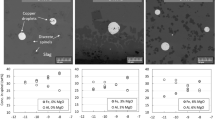Abstract
Powders and dusts from e-waste recycling processes are a valuable source for different metals like copper or precious metals such as silver and gold. Hence, the recycling of this fine fraction is of great interest. In addition to these precious metals, large amounts of organic, ceramic, and oxidic elements emerge, which have a tremendous influence on slag properties and the entire melting process. In order to recycle the valuable metals and use the energy of the material accompanying the organic constituents, the IME Institute of RWTH Aachen University is conducting research on the metallurgical effects of these fractions when introduced into a molten slag bath and developing solutions to recycle the component metals. Within this research, the influences on the slag phase are simulated using the thermochemical software FactSage™, and the material-specific oxygen amount required to combust the organic constituents is calculated. The results are tested and optimized in preliminary laboratory-scale experiments and later scaled up to technical size. The experimental results show a possible reduction in the slag phase’s liquidus temperature by adding different additives and the feasibility of autothermal melting of fine fractions with good metal recovery rates and low metal distribution to the mineral phase.


















Similar content being viewed by others
References
Baldé C et al (2015) The global E-waste monitor—2014. United Nations University
Rhamdhani M et al (2014) Metal extraction processes for electronic waste and existing industrial routes: a review and australian perspective. Resources 3(1):152–179
Veit H, Bernardes A (2015) Electronic waste: recycling techniques. Springer, Berlin
Bartos R et al (2015) Stahlfibel. Verlag Stahleinsen GmbH
Wang S et al (2003) Verhalten der Reduktion und Volumenänderung von selbstreduzierenden Pellets mit DSD und Kohle als Reduktionsmittel, 18. Aachener Stahlkolloqium, pp 29–41
Kowitwarangkul P (2014) Reduction behavior of self-reducing pellet (SRP) for low height blast furnace. Steel Res Int 85(11):1501–1509
Nascimiento RC et al (1999) Kinetics and catastrophic swelling during reduction of iron ore in carbon bearing pellets. Ironmak Steelmak 26(3):182–186
Lahiri AK et al (2004) Foaminess of slag: cause and control. In: VII international conference on molten slags fluxes and salts. The South African Institute of Mining and Metallurgy, Johannesburg
Liukkonen M et al (2012) A compilation of slag foaming phenomenon research theoretical studies, industrial experiments and modelling. VTT Technology 63
Merz M et al (2006) New slag foaming experiences with high-chromium steels. Stahl und Eisen 126(1):49–53
Shaw D (1996) Recycling of oily millscale and EAF-baghouse dust by re-injection into an EAF using the carbofer process. Working party on steel, seminar on the processing, utilization and disposal of waste in the steel industry, Ungarn
Liebman M (2000) The current status of electric arc furnace dust recycling in North America, in Recycling of metals and engineered materials. Wiley, Hoboken
Krüger J et al (1998) Einsatz von sekundären, zink- und bleihaltigen Materialien bei der Sinterröstung im Imperial Smelting Prozess. Rohstofftechnik im Wandel, Aachener Umwelttage der Fakultät für Bergbau, Hüttenwesen und Geowissenschaften
Wang R et al (2014) Recycling of non-metallic fractions from waste electrical and electronic equipment (WEEE): a review. Elsevier, Amsterdam
Hagelüken C (2006) Improving metal returns and eco-efficiency in electronics recycling—a holistic approach for interface optimization between pre-processing and integrated metals smelting and refining. In: Proceedings of the 2006 IEEE international conference
Rotter V et al (2014) Anlagenbilanzierung als Bewertungsinstrument für eine Qualitäts-recycling von Elektroaltgeräten. Recycling und Rohstoffe 7:191–203
Martens H (2011) Recycling von Elektro-und Elektronikaltgeräten. In: Recyclingtechnik, pp 273–301
Bigum M et al (2012) Metal recovery from high-grade WEEE: a life cycle assessment. J Hazard Mater 207–208:8–14
Chancerel P et al (2009) Edelmetallrückgewinnung aus Elektro- und Elektronikaltgeräten durch Aufbereitung. Müll und Abfall 2:78–82
Wang F et al (2015) Mineralogical analysis of dust collected from typical recycling line of waste printed circuit boards. Waste Manag 43:434–441
Espinosa D et al (2015) Electronic waste: recycling techniques (chapter 8). Springer, Berlin
Shuey SA et al (2006) Pyrometallurgical processing of electronic waste. In: SME Annual Meeting
Ogunniyi IO et al (2009) Chemical composition and liberation characterization of printed circuit board comminution fines for beneficiation investigations. Waste Manag 29(7):2140–2146
Acknowledgments
We offer our special thanks to the Stein Injection Technology GmbH for providing the injection equipment and the knowhow. This project is promoted by the federal Ministry for Economy and Energy according to a decision of the German federal parliament.
Author information
Authors and Affiliations
Corresponding author
Additional information
The contributing editor for this article was Hiromichi Takebe.
Rights and permissions
About this article
Cite this article
Borowski, N., Trentmann, A., Brinkmann, F. et al. Metallurgical Effects of Introducing Powdered WEEE to a Molten Slag Bath. J. Sustain. Metall. 4, 233–250 (2018). https://doi.org/10.1007/s40831-018-0159-3
Published:
Issue Date:
DOI: https://doi.org/10.1007/s40831-018-0159-3




